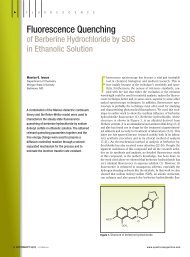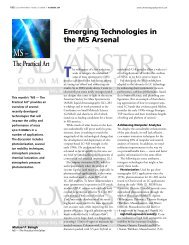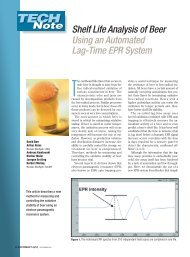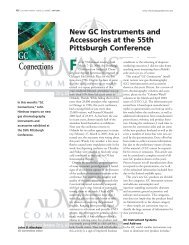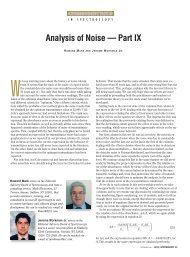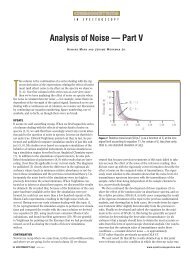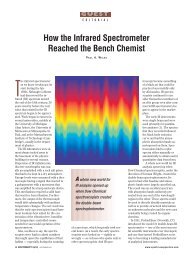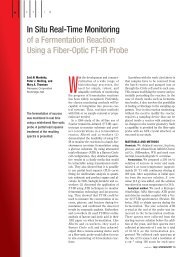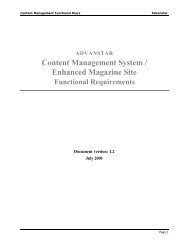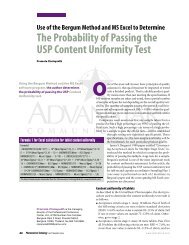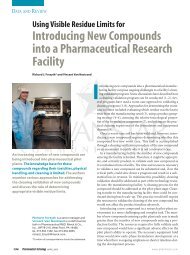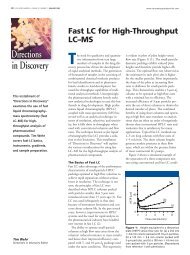pesup0503_008-10 Intro - Chromatography Online
pesup0503_008-10 Intro - Chromatography Online
pesup0503_008-10 Intro - Chromatography Online
You also want an ePaper? Increase the reach of your titles
YUMPU automatically turns print PDFs into web optimized ePapers that Google loves.
INTRODUCTION<br />
When the Going Gets Tough,<br />
the Tough Get Incentives<br />
Sibyl Shalo, SENIOR EDITOR<br />
Investment in pharma sales force productivity pays for itself.<br />
Ken Lenoci had a tough job. In 1994, as a sales rep<br />
for A.H. Robins, one of Wyeth-Ayerst’s late-1980s<br />
acquisitions, he worked hard just getting his foot<br />
in doctors’ doors, not to mention jumping office staff<br />
hurdles. I spent a day pounding the pavement with him<br />
when the PR agency I then worked for launched<br />
Wyeth’s newly approved antidepressant Effexor (venlafaxine).<br />
Starting with only a handful of data and a<br />
couple of medical journal articles made all of our jobs<br />
more challenging, but it was Lenoci and his colleagues<br />
in the field who had it the worst. Although his territory<br />
included some of the “early adopters,” psychiatrists<br />
who had begun prescribing Effexor after reading about<br />
its clinical trial successes in Europe, there were many<br />
more doctors who weren’t willing to try something new.<br />
As the day wore on, the grind wore on me—in and out<br />
of the cramped company car, in and out of stuffy waiting<br />
rooms, in and out of offices in which the only conversation<br />
Lenoci had was with a receptionist shaking<br />
her head behind a pane of glass. My heart went out to<br />
him every time his efforts to educate were thwarted, but<br />
Lenoci had a thick skin and shrugged it off, eager and<br />
ready for his next customer. I returned home with a new<br />
appreciation for pharma sales people, relieved that I<br />
wouldn’t have to repeat the experience and motivated<br />
to help our client support its reps as they toiled in the<br />
field.<br />
Nearly a decade later, I imagine that, in some ways,<br />
Lenoci’s job is easier: He’s had nine years to strengthen<br />
the relationships he worked so hard to cultivate back<br />
then. But it’s much more likely that his job has become<br />
even more difficult. He now competes with more than<br />
double the number of pharma sales reps than he did in<br />
8 May 2003 Pharmaceutical Executive Supplement Successful Sales Management www.PharmExec.com
INTRODUCTION<br />
the mid-1990s. That’s just one of the challenges that<br />
make today’s pharma selling environment so hostile.<br />
Reps have also lost some of the tools they once had<br />
to gain physicians’ attention.<br />
The PhRMA Code for Interaction with Healthcare<br />
Professionals eliminated reps’ ability to compensate<br />
doctors for their time. Ironically, the pharma industry<br />
sought to repair its damaged relationship with the<br />
medical community by adopting the code, but as<br />
Charlene Prounis describes in “What Doctors Want,”<br />
many doctors don’t see it that way. According to her<br />
research, they don’t appreciate the code and believe<br />
that it will drive an even deeper wedge between them<br />
and reps.<br />
On top of that is reps’ concern that the growing<br />
use and popularity of e-detailing may soon put them<br />
out of their jobs. And although pharma companies<br />
and their suppliers dismiss that concern, saying that<br />
e-detailing augments rather than replaces faceto-face<br />
meetings, the question on everyone’s mind is:<br />
Can the industry sustain the growth of a sales force<br />
that already has more than 80,000–90,000, reps on<br />
the street?<br />
Authors of articles in PE’s first sales management<br />
supplement answer with a qualified “yes,” arguing<br />
that companies must<br />
■ improve the way they recruit and hire<br />
salespeople<br />
■ better understand all prescribers, not just<br />
physicians<br />
■ learn from other industries ways to motivate<br />
sales reps<br />
■ energize sales training meetings and programs<br />
■ equip sales reps with tools that help them make<br />
the most of every minute.<br />
Divided by subject into three sections—relationships,<br />
incentives, and training and tools—the pages<br />
ahead reveal emerging trends in the doctor–sales rep<br />
relationship, showcase companies’ real-world sales<br />
experiences, and recommend ways to help sales forces<br />
overcome obstacles to achieve the highest levels of<br />
success.<br />
This month’s cover story, “Reason to Achieve,”<br />
represents PE’s foray into some uncharted territory—<br />
the intersection of pharma and incentive marketing.<br />
Although the relationship between the two isn’t new,<br />
Erika Rasmusson’s report shows that pharma companies<br />
are making increased use of merchandise, travel, and<br />
gift certificate rewards to galvanize reps into action<br />
and keep them motivated. That trend surprised some<br />
incentive program providers who misunderstood the<br />
restrictions stipulated by PhRMA’s code; they thought<br />
it applied not only to incentives for doctors but incentives<br />
for pharma company employees as well. Other<br />
incentive marketing companies know, from the growth<br />
of their pharma sector business, that industry is<br />
rewarding reps for their achievements in a crowded<br />
and harsh marketplace.<br />
Thus, pharma sales managers’ challenge is as<br />
difficult as reps’—to find new ways to support their<br />
field force in the face of tumultuous mergers, mounting<br />
financial pressures, and burgeoning competition in most<br />
therapeutic categories. But there’s hope that pharma<br />
can still attract and keep good sales people. In his<br />
article “Every Rep a Star,” Garry O’Grady explains that<br />
optimizing sales force productivity is more about quality<br />
than quantity. And in “Detail Diagnosis,” Michael<br />
Kessler, MD, and his colleagues illustrate a technique<br />
that uses real doctor–rep interactions to evaluate reps’<br />
performance.<br />
Carrying the bag in 2003 also requires 21st century<br />
equipment and training. In “Tomorrow’s CRM,” Len<br />
Weinstein and Kim Ramko paint a picture of tomorrow’s<br />
customer relationship management applications and<br />
capabilities. In “Training for Peak Performance,”<br />
Christine Creter and Dow Summey recommend strategies<br />
for making training meetings both memorable and<br />
fun. In “Bring in the Reinforcements,” Lyn O’Connor Vos<br />
suggests that contract sales organizations have become<br />
more valuable as their involvement in companies’<br />
marketing plans expand. Finally, in his column<br />
“Neglected Prescribers,” Steven Tarnoff asserts that for<br />
pharma marketing plans to succeed, sales forces must<br />
find ways to sample high-prescribing nurse practitioners<br />
and physician assistants.<br />
The good news for Ken Lenoci, wherever he is now,<br />
and for his comrades and competitors in the field, is that<br />
ramping up spending to prepare, train, motivate, and<br />
reward reps for their perseverance is good business.<br />
If sales managers do those things well, the investment<br />
will pay for itself. ■<br />
9 May 2003 Pharmaceutical Executive Supplement Successful Sales Management www.PharmExec.com



